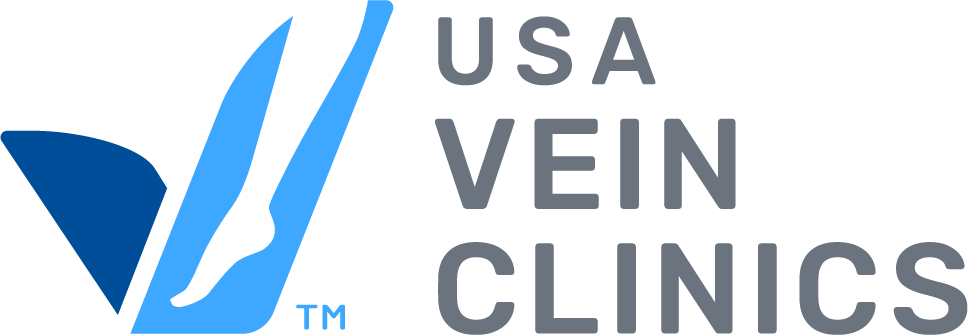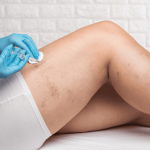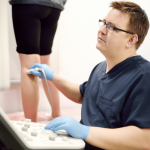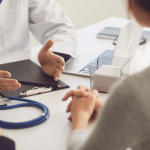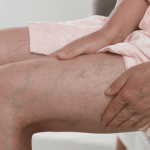
You have just had a baby, or maybe you’re expecting – either way, congratulations! As you know, pregnancy can be hard on the body, due to the many changes you go through. One of the undesirable changes you may experience during or after pregnancy is varicose veins and spider veins.
This post will focus on the physiologic reasons pregnancy can create varicose veins as well as postpartum vein treatment options that are safe while breastfeeding. First, let’s dive into what our amazing bodies go through on the circulatory level to help create and support that beautiful baby.
Pregnancy and its effect on your veins
Hormones
As you may already know, one of the main things that change once you are pregnant is your hormones. These affect everything from our ability to retain the pregnancy, our sense of smell and choices in food, our emotions and believe it or not, our veins.
Progesterone is a critical hormone when it comes to maintaining a healthy pregnancy. It helps strengthen the pelvic walls for labor, prevents lactation during pregnancy, stimulates maternal breast tissue growth, regulates the condition of the lining endometrium, and allows the veins and arteries to stretch more to compensate for additional blood flow to and from the baby to promote growth.
Increase in blood volume
The blood volume needed to supply the baby’s growth increases significantly during pregnancy. In fact, our blood volume during pregnancy increases an average of 45% with a range of 30-100%. Now that is a lot of extra blood.
This is where progesterone comes back into play, allowing for our vessels to stretch and compensate for all of this additional blood volume. Unlike arteries, vein walls are elastic, and work with our muscle contractions in conjunction with one way valves to move blood flow back toward the heart. Sometimes when veins are stretched during pregnancy, they don’t quite retract to their original size. This allows venous blood to flow in the wrong direction, creating bulging varicose veins, and or spider veins.
Pressure
As you get closer to your due date, the harder your body continues to work against gravity to get the venous blood flow out of your legs and back toward your heart and lungs. As the baby grows, your pelvis is put under additional pressure, potentially obstructing, or partially obstructing the veins that pass through your pelvis as well as your legs.
While this article focuses on postpartum vein treatment while breastfeeding, we also wrote about how to treat your vein issues during pregnancy. Learn how best to treat varicose veins during pregnancy here.
Multiparity
With each additional pregnancy, it becomes harder and harder for your veins to retain the elasticity they need to recoil back to their original size. I think we can all appreciate that. As the veins become more stretched, the valves no longer touch, and venous flow is able to move the wrong way with the help of gravity, back toward your feet. This can cause new varicose veins or the ones that already existed to become more noticeable.
Genetics
As with most things, genetics play a large role in our vein health. Unfortunately, if a parent, grandparent or great grandparent experience varicose veins or spider veins, you are much more likely to have varicose veins, particularly during, and after pregnancy.
At home varicose vein relief options
While not a vein treatment, a few at home vein treatment options can provide temporary relief to common signs and symptoms associated with vein issues, including:
- Wearing graduated compression stockings.
- Elevating your legs when possible – try putting your legs up against a wall while you lie down during baby’s tummy time.
- Avoid standing or sitting for extended periods of time.
- Perform exercises that contract your legs muscles such as calf raises, squats or lunges.
- Take 15-30min walks, two to three times per day.
If these at home options just aren’t enough to relieve the uncomfortable effects of varicose or spider veins, we encourage you to meet with one of our vein specialists. While waiting until you have finished breastfeeding is ideal, the good news is vein treatments while breastfeeding IS SAFE.
Since breastfeeding is the ideal nourishment for a baby, and since it offers so many other benefits as well, we recommend that you nurse your baby as long as you feel is appropriate.
Vein treatment while breastfeeding
Let’s be honest, the last thing most mothers want to think about after giving birth are additional doctor appointments to address their veins. For many though, the pain, discomfort or even the visual aspect of their veins means waiting to have vein treatment once finished breastfeeding can seem like too long of a wait to finally have relief. Read more expert-approved tips for managing vein pain and discomfort.
Vein treatments vary for each patient depending on the source and severity of their vein disease. Most treatment options involve damaging veins so they shut down, diverting the blood to normal, healthy veins.
Note: You should always discuss your options and your personal medical history with your physician prior to receiving any vein treatment.
Postpartum vein treatment options that are safe while breastfeeding
Radiofrequency Ablation and/or Laser Ablation: Radiofrequency ablation and/or laser ablation designed to target the large veins pushing and creating the varicose veins you may feel or see closer to the surface of the skin. While the localized numbing medication used for this, Tumescent, uses lidocaine, typically there are no negative side effects and treatments can proceed as normal.
Endovenous Adhesive Ablation: Endovenous adhesive ablation targets the larger, source veins. There only 1-2 small, localized lidocaine shots are used for this procedure. Typically, there are no negative side effects and treatments can proceed as normal.
Sclerotherapy: Sclerotherapy is used to target and close the larger varicose vein branches as well as spider veins. For this procedure a chemical solution called a sclerosant is used. In more recent years there are studies starting to emerge saying you can have these injections while breastfeeding as normal. The consensus, however, is to err on the side of caution and use a “pump and dump” method for 48-72 hours following any sclerotherapy injections. This time frame allows the medication to clear your system.
Overall, these treatments are recommended by many physicians who perform these varicose vein procedures. However, the particular physician who you may see for varicose vein treatment may give slightly different opinions regarding the topic of treatment while breastfeeding.
Know that you are not alone
Usually, veins regain their original size within 3-6 months of delivery. If the veins do not reduce in size between 6-12 months postpartum, they will usually stay and eventually progress. Approximately 25% of women have visible varicose veins after 6 months postpartum, some of which will need management or treatment within 12 months after delivery due to swelling and pain.
Although you can wait to seek treatment following breastfeeding, if you find that your symptoms are too great to endure, seek treatment from a vein specialist.
